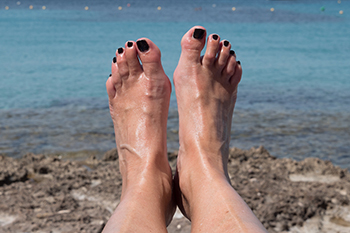159 North 3rd Street
Macclenny, Florida 32063

Most people who are diabetic know the importance of checking their feet daily, even when their feet feel good. Neuropathy is a common condition that can affect diabetic patients, and it is defined as being unable to feel existing cuts, bruises, or scrapes that have developed on the feet. It can happen as a result of damaged nerve endings from increased levels of insulin in the blood. Washing and drying the feet thoroughly is essential in diabetic foot care. It is suggested to refrain from walking barefoot and to wear comfortable shoes. Additionally, trimming the toenails correctly may help to prevent ingrown toenails, and engaging in a mild exercise routine can help to control blood sugar levels. If you have diabetes, it is strongly advised that you are under the care of a podiatrist who can frequently check the condition of your feet and offer you correct management techniques.
Diabetic foot care is important in preventing foot ailments such as ulcers. If you are suffering from diabetes or have any other concerns about your feet, contact Dr. John L. Coleman from Florida. Our doctor can provide the care you need to keep you pain-free and on your feet.
Diabetic Foot Care
Diabetes affects millions of people every year. The condition can damage blood vessels in many parts of the body, especially the feet. Because of this, taking care of your feet is essential if you have diabetes, and having a podiatrist help monitor your foot health is highly recommended.
The Importance of Caring for Your Feet
Patients with diabetes should have their doctor monitor their blood levels, as blood sugar levels play such a huge role in diabetic care. Monitoring these levels on a regular basis is highly advised.
It is always best to inform your healthcare professional of any concerns you may have regarding your feet, especially for diabetic patients. Early treatment and routine foot examinations are keys to maintaining proper health, especially because severe complications can arise if proper treatment is not applied.
If you have any questions please feel free to contact our office located in Macclenny, FL . We offer the newest diagnostic and treatment technologies for all your foot and ankle needs.

Nerve and circulatory damage resulting from diabetes is common and can lead to injuries to the feet and lower legs. In extreme cases, amputation is required. Amputations are the end result of foot or leg ulcers that did not heal or cannot heal. Diabetic neuropathy and peripheral artery disease (PAD) are contributing factors to this occurrence. Neuropathy makes it hard to detect cuts and sores, which may become infected. PAD then slows the healing process, causing ulcers, which if left unattended can lead to gangrene. At some point removing the ulcerated area can give way to removing the foot or limb. The two main actions that may help to keep this chain reaction from occurring are blood sugar maintenance and proper foot care. Reducing stress and eating healthy food is a good beginning. Refraining from smoking and alcohol consumption, both of which contribute to nerve damage and poor circulation, is highly recommended by experts. Losing weight and keeping track of blood sugar levels is essential. Daily foot care is imperative, including keeping feet clean and dry and checking for sores, cuts, and blisters. Moving the toes and feet to encourage better blood flow and wearing shoes that fit properly also help. If you have questions regarding proper diabetic foot care, please visit a podiatrist as soon as possible.
Diabetic Limb Salvage
Diabetic limb salvage can be an effective way in preventing the need for limb amputation. If you have a foot ulcer and diabetes, consult with Dr. John L. Coleman from Florida. Our doctor will assess your condition and provide you with quality foot and ankle treatment.
What Is Diabetic Limb Salvage?
Diabetic limb salvage is the attempt of saving a limb, such as the foot, that has an infected ulcer, from amputation. Podiatrists also try to make sure that there is enough function in the foot after the salvage that it is still usable. Those with diabetes experience poor blood circulation, which prevents proper healing of an ulcer. If the ulcer is left uncheck, it could become infected, which could result in the need for amputation.
Diabetes is the number one cause of non-traumatic amputations in the United States. Amputation has been found to lead to higher mortality rates. This translates into higher healthcare costs, and a reduced quality of life and mobility for amputees. Podiatrists have attempted to increase the prevalence of limb salvage in an attempt to solve these issues.
Diagnosis and Treatment
Limb salvage teams have grown in recent years that utilize a number of different treatments to save the infected limb. This includes podiatrists that specialize in wound care, rehabilitation, orthotics, and surgery. Through a combination of these methods, limb salvage has been found to be an effective treatment for infected limbs, and as an alternative to amputation. Podiatrists will first evaluate the potential for limb salvage and determine if the limb can be saved or must be amputated.
If you have any questions, please feel free to contact our office located in Macclenny, FL . We offer the newest diagnostic and treatment technologies for all your foot care needs.

One of the symptoms of poor circulation is having cold feet. Additional symptoms include swelling, chronic pain, difficulty moving the feet. Many people feel a tingling or numbing sensation in their feet, which may make their feet feel heavy. The common reasons poor circulation may be prevalent among seniors include having diabetes, being overweight, smoking, and living a sedentary lifestyle. There also may be existing medical conditions that contribute to having poor circulation. Among them are having peripheral artery disease (PAD), atherosclerosis, or a venous insufficiency. Circulation can be improved by making lifestyle changes. It is beneficial to incorporate a simple exercise routine daily, and it is important to consume a healthy diet. Some patients find relief when they elevate their feet, and it may help to wear compression stockings. If you would like more information about the causes and remedies of poor circulation in the feet, please confer with a podiatrist.
While poor circulation itself isn’t a condition; it is a symptom of another underlying health condition you may have. If you have any concerns with poor circulation in your feet contact Dr. John L. Coleman of Florida. Our doctor will treat your foot and ankle needs.
Poor Circulation in the Feet
Peripheral artery disease (PAD) can potentially lead to poor circulation in the lower extremities. PAD is a condition that causes the blood vessels and arteries to narrow. In a linked condition called atherosclerosis, the arteries stiffen up due to a buildup of plaque in the arteries and blood vessels. These two conditions can cause a decrease in the amount of blood that flows to your extremities, therefore resulting in pain.
Symptoms
Some of the most common symptoms of poor circulation are:
Treatment for poor circulation often depends on the underlying condition that causes it. Methods for treatment may include insulin for diabetes, special exercise programs, surgery for varicose veins, or compression socks for swollen legs.
As always, see a podiatrist as he or she will assist in finding a regimen that suits you. A podiatrist can also prescribe you any needed medication.
If you have any questions, please feel free to contact our office located in Macclenny, FL . We offer the newest diagnostic and treatment technologies for all your foot care needs.

If you care for your children’s feet as they grow, this can help protect them from having problems with their feet as adults. Practicing a regular routine when it comes to caring for children’s feet is similar to what is recommended for adults. Wash your child’s feet every day, dry them carefully, and apply a bit of baby powder to keep them healthy. Buy them shoes that fit right – whether they are at the soft or hard shoe stage. Make sure that the shoes have enough room in the foot box for the toes to grow. Use socks made of cotton or wool and that fit properly without pinching your child’s feet. Cut their toenails in a straight line so that they do not develop ingrown toenails. Allow your children to go barefoot around the house so that their feet will develop and gain strength without being restricted. If questions or problems arise related to your children’s feet, consult with a podiatrist, an expert in this area.
The health of a child’s feet is vital to their overall well-being. If you have any questions regarding foot health, contact Dr. John L. Coleman of Florida. Our doctor can provide the care you need to keep you pain-free and on your feet.
Tips for Keeping Children's Feet Healthy
If you have any questions, please feel free to contact our office located in Macclenny, FL . We offer the newest diagnostic and treatment technologies for all your foot care needs.

Some afflictions of the foot occur when a local nerve is damaged or strained, which can result in complications in the feet. Tarsal tunnel syndrome is one such foot affliction. This condition occurs in an individual when the tissue surrounding the tarsal tunnel aggravates the posterior tibial nerve. This nerve is located in the lower calf and runs to the heel of the foot. When this nerve aggravation occurs, the patient can feel pain when walking. By working with a podiatrist, a patient can receive a diagnosis of tarsal tunnel syndrome. There are different ways in which a podiatrist might go about making a diagnosis. In some cases, a podiatrist might conduct a simple examination of the affected foot. In other cases, the podiatrist might use nerve conduction studies. These studies essentially use electrical currents to measure the speed with which a nerve can produce impulses. If the posterior tibial nerve being studied produces impulses at a very slow rate, this can indicate the presence of tarsal tunnel syndrome. Regardless of how a diagnosis of tarsal tunnel syndrome is performed, it can be very helpful to reach out to a podiatrist who will be able to best help you identify and treat this condition.
Tarsal tunnel syndrome can be very uncomfortable to live with. If you are experiencing tarsal tunnel syndrome, contact Dr. John L. Coleman of Florida. Our doctor can provide the care you need to keep you pain-free and on your feet.
Tarsal Tunnel Syndrome
Tarsal tunnel syndrome, which can also be called tibial nerve dysfunction, is an uncommon condition of misfiring peripheral nerves in the foot. The tibial nerve is the peripheral nerve in the leg responsible for sensation and movement of the foot and calf muscles. In tarsal tunnel syndrome, the tibial nerve is damaged, causing problems with movement and feeling in the foot of the affected leg.
Common Cause of Tarsal Tunnel Syndrome
The Effects of Tarsal Tunnel Syndrome
A physical exam of the leg can help identify the presence of tarsal tunnel syndrome. Medical tests, such as a nerve biopsy, are also used to diagnose the condition. Patients may receive physical therapy and prescriptive medication. In extreme cases, some may require surgery.
If you have any questions please feel free to contact our office located in Macclenny, FL . We offer the newest diagnostic and treatment technologies for all your foot and ankle needs.